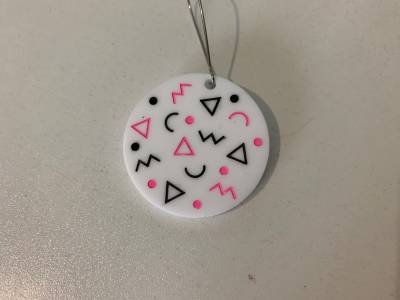AR Wearables
Augmented Reality Earring Testing
Learn more about AR technology here
Image Marker
For this trial, earrings were designed in Inkscape and cut in acrylic on the laser cutter. The earrings are the target or marker used to activate the animation using a mobile app.
These photos were used with the background (white) removed and saved as transparent PNGs;


Video Animation
The video animation was designed in VR with the art program Tilt Brush, to get the same design structure, a PNG image of the earring was imported into Tilt Brush to trace out the design.
The next step was to key out the background colour, again this was white, I tried a black background but too much black tone in the animated brush used in Tilt Brush. With the AR apps I used to test the overlay, one has colour keying on upload (Artivive) so choosing a colour to key out was one of the difficulties of using multi-coloured animations but white seemed to work ok.
The other method of keying out the video was by using masks in After Effects, which was easy for the circle based earring, for the palm tree I used the keying 'Extract colour' effect to save time.
AR App test
I tested the AR in both Artivive and an app called Eye Jack. The palm tree doesn't work so well as there is not enough definition as a marker.
The circle one worked much better since it had more graphics that helped define it as a marker. Artivive was the easiest app and interface to get working and capture the following footage.
3D AR Model
Next step was looking at activating 3D Tilt Brush models/creations as AR. Using Unity and the Poly toolkit integration work so smoothly with no real issues, you can follow along with Unity's own guide which is pretty straightforward. It basically brings in your Tilt Brush or Blocks models direct from the online Poly hosting site, you don't have to have your models live either, they can be unpublished as you sign in to your Google account to access.
Asset store link - https://assetstore.unity.com/packages/templates/systems/poly-toolkit-104464
Poly guide here - https://developers.google.com/poly/develop/toolkit-unity
AR App Creating
Next step in my testing is to use Vuforia to host AR work and create a basic mobile app to use to activate the AR. I signed up for a Vuforia account years ago when I first started using AR and was doing 2D animations, it's pretty straightforward to sign up for free as a developer and get started uploading markers and

